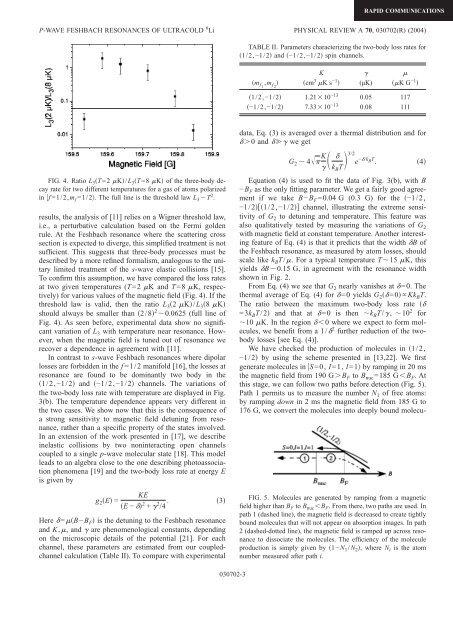Martin Teichmann Atomes de lithium-6 ultra froids dans la ... - TEL
Martin Teichmann Atomes de lithium-6 ultra froids dans la ... - TEL
Martin Teichmann Atomes de lithium-6 ultra froids dans la ... - TEL
Create successful ePaper yourself
Turn your PDF publications into a flip-book with our unique Google optimized e-Paper software.
P-WAVE FESHBACH RESONANCES OF ULTRACOLD 6 Li PHYSICAL REVIEW A 70, 030702(R) (2004)<br />
FIG. 4. Ratio L 3�T=2 �K�/L 3�T=8 �K� of the three-body <strong>de</strong>cay<br />
rate for two different temperatures for a gas of atoms po<strong>la</strong>rized<br />
in �f =1/2,m f =1/2�. The full line is the threshold <strong>la</strong>w L 3�T 2 .<br />
results, the analysis of [11] relies on a Wigner threshold <strong>la</strong>w,<br />
i.e., a perturbative calcu<strong>la</strong>tion based on the Fermi gol<strong>de</strong>n<br />
rule. At the Feshbach resonance where the scattering cross<br />
section is expected to diverge, this simplified treatment is not<br />
sufficient. This suggests that three-body processes must be<br />
<strong>de</strong>scribed by a more refined formalism, analogous to the unitary<br />
limited treatment of the s-wave e<strong>la</strong>stic collisions [15].<br />
To confirm this assumption, we have compared the loss rates<br />
at two given temperatures (T=2 �K and T=8 �K, respectively)<br />
for various values of the magnetic field (Fig. 4). Ifthe<br />
threshold <strong>la</strong>w is valid, then the ratio L 3�2 �K�/L 3�8 �K�<br />
should always be smaller than �2/8� 2 �0.0625 (full line of<br />
Fig. 4). As seen before, experimental data show no significant<br />
variation of L 3 with temperature near resonance. However,<br />
when the magnetic field is tuned out of resonance we<br />
recover a <strong>de</strong>pen<strong>de</strong>nce in agreement with [11].<br />
In contrast to s-wave Feshbach resonances where dipo<strong>la</strong>r<br />
losses are forbid<strong>de</strong>n in the f =1/2 manifold [16], the losses at<br />
resonance are found to be dominantly two body in the<br />
�1/2,−1/2� and �−1/2,−1/2� channels. The variations of<br />
the two-body loss rate with temperature are disp<strong>la</strong>yed in Fig.<br />
3(b). The temperature <strong>de</strong>pen<strong>de</strong>nce appears very different in<br />
the two cases. We show now that this is the consequence of<br />
a strong sensitivity to magnetic field <strong>de</strong>tuning from resonance,<br />
rather than a specific property of the states involved.<br />
In an extension of the work presented in [17], we <strong>de</strong>scribe<br />
ine<strong>la</strong>stic collisions by two noninteracting open channels<br />
coupled to a single p-wave molecu<strong>la</strong>r state [18]. This mo<strong>de</strong>l<br />
leads to an algebra close to the one <strong>de</strong>scribing photoassociation<br />
phenomena [19] and the two-body loss rate at energy E<br />
is given by<br />
g 2�E� =<br />
KE<br />
�E − �� 2 + � 2 /4<br />
. �3�<br />
Here �=��B−B F� is the <strong>de</strong>tuning to the Feshbach resonance<br />
and K,�, and � are phenomenological constants, <strong>de</strong>pending<br />
on the microscopic <strong>de</strong>tails of the potential [21]. For each<br />
channel, these parameters are estimated from our coupledchannel<br />
calcu<strong>la</strong>tion (Table II). To compare with experimental<br />
030702-3<br />
TABLE II. Parameters characterizing the two-body loss rates for<br />
�1/2,−1/2� and �−1/2,−1/2� spin channels.<br />
K � �<br />
�m f1 ,m f2 � �cm 3 �Ks −1 � (µK) ��KG −1 �<br />
�1/2,−1/2� 1.21�10 −13 0.05 117<br />
�−1/2,−1/2� 7.33�10 −13 0.08 111<br />
data, Eq. (3) is averaged over a thermal distribution and for<br />
��0 and ��� we get<br />
G2 � 4�� K<br />
�� �<br />
e−�/kBT . �4�<br />
Equation (4) is used to fit the data of Fig. 3(b), with B<br />
−BF as the only fitting parameter. We get a fairly good agreement<br />
if we take B−B F=0.04 G (0.3 G) for the �−1/2,<br />
−1/2���1/2,−1/2�� channel, illustrating the extreme sensitivity<br />
of G2 to <strong>de</strong>tuning and temperature. This feature was<br />
also qualitatively tested by measuring the variations of G2 with magnetic field at constant temperature. Another interesting<br />
feature of Eq. (4) is that it predicts that the width �B of<br />
the Feshbach resonance, as measured by atom losses, should<br />
scale like kBT/�. For a typical temperature T�15 �K, this<br />
yields �B�0.15 G, in agreement with the resonance width<br />
shown in Fig. 2.<br />
From Eq. (4) we see that G2 nearly vanishes at �=0. The<br />
thermal average of Eq. (4) for �=0 yields G2��=0��KkBT. The ratio between the maximum two-body loss rate ��<br />
=3kBT/2� and that at �=0 is then �kBT/�, �102 for<br />
�10 �K. In the region ��0 where we expect to form molecules,<br />
we benefit from a 1/� 2 further reduction of the twobody<br />
losses [see Eq. (4)].<br />
We have checked the production of molecules in �1/2,<br />
−1/2� by using the scheme presented in [13,22]. We first<br />
generate molecules in �S=0, I=1, l=1� by ramping in 20 ms<br />
the magnetic field from 190 G�B F to Bnuc=185 G�B F.At<br />
this stage, we can follow two paths before <strong>de</strong>tection (Fig. 5).<br />
Path 1 permits us to measure the number N1 of free atoms:<br />
by ramping down in 2 ms the magnetic field from 185 G to<br />
176 G, we convert the molecules into <strong>de</strong>eply bound molecu-<br />
3/2<br />
kBT� RAPID COMMUNICATIONS<br />
FIG. 5. Molecules are generated by ramping from a magnetic<br />
field higher than B F to B nuc�B F. From there, two paths are used. In<br />
path 1 (dashed line), the magnetic field is <strong>de</strong>creased to create tightly<br />
bound molecules that will not appear on absorption images. In path<br />
2 (dashed-dotted line), the magnetic field is ramped up across resonance<br />
to dissociate the molecules. The efficiency of the molecule<br />
production is simply given by �1−N 1/N 2�, where N i is the atom<br />
number measured after path i.

















